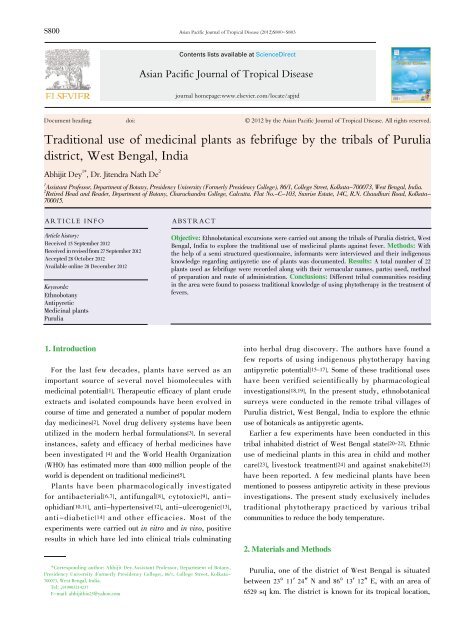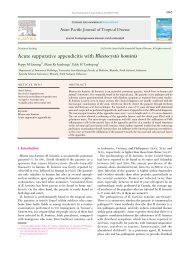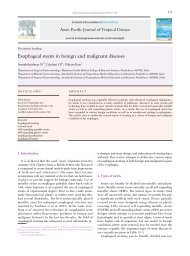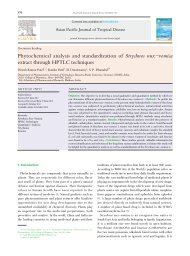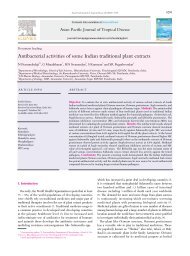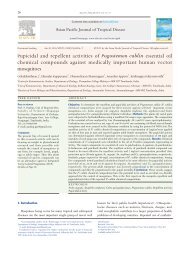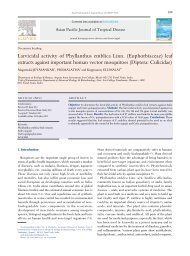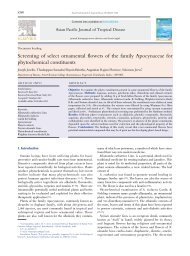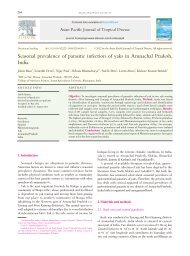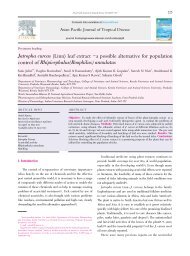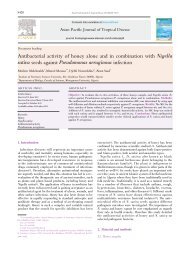Traditional use of medicinal plants as febrifuge by the ... - Apjtcm.com
Traditional use of medicinal plants as febrifuge by the ... - Apjtcm.com
Traditional use of medicinal plants as febrifuge by the ... - Apjtcm.com
Create successful ePaper yourself
Turn your PDF publications into a flip-book with our unique Google optimized e-Paper software.
S800<br />
Document heading doi: 襃 襃 2012 <strong>by</strong> <strong>the</strong> Asian Pacific Journal <strong>of</strong> Tropical Dise<strong>as</strong>e. All rights reserved.<br />
<strong>Traditional</strong> <strong>use</strong> <strong>of</strong> <strong>medicinal</strong> <strong>plants</strong> <strong>as</strong> <strong>febrifuge</strong> <strong>by</strong> <strong>the</strong> tribals <strong>of</strong> Purulia<br />
district, West Bengal, India<br />
Abhijit Dey 1* , Dr. Jitendra Nath De 2<br />
1 Assistant Pr<strong>of</strong>essor, Department <strong>of</strong> Botany, Presidency University (Formerly Presidency College), 86/1, College Street, Kolkata-700073, West Bengal, India.<br />
2 Retired Head and Reader, Department <strong>of</strong> Botany, Charuchandra College, Calcutta. Flat No.-C-103, Sunrise Estate, 14C, R.N. Chaudhuri Road, Kolkata-<br />
700015.<br />
ARTICLE INFO ABSTRACT<br />
Article history:<br />
Received 15 September 2012<br />
Received in revised from 27 September 2012<br />
Accepted 28 October 2012<br />
Available online 28 December 2012<br />
Keywords:<br />
Ethnobotany<br />
Antipyretic<br />
Medicinal <strong>plants</strong><br />
Purulia<br />
1. Introduction<br />
Asian Pacific Journal <strong>of</strong> Tropical Dise<strong>as</strong>e (2012)S800-S803<br />
Asian Pacific Journal <strong>of</strong> Tropical Dise<strong>as</strong>e<br />
For <strong>the</strong> l<strong>as</strong>t few decades, <strong>plants</strong> have served <strong>as</strong> an<br />
important source <strong>of</strong> several novel biomolecules with<br />
<strong>medicinal</strong> potential[1]. Therapeutic efficacy <strong>of</strong> plant crude<br />
extracts and isolated <strong>com</strong>pounds have been evolved in<br />
course <strong>of</strong> time and generated a number <strong>of</strong> popular modern<br />
day medicines[2]. Novel drug delivery systems have been<br />
utilized in <strong>the</strong> modern herbal formulations[3]. In several<br />
instances, safety and efficacy <strong>of</strong> herbal medicines have<br />
been investigated [4] and <strong>the</strong> World Health Organization<br />
(WHO) h<strong>as</strong> estimated more than 4000 million people <strong>of</strong> <strong>the</strong><br />
world is dependent on traditional medicine[5].<br />
Plants have been pharmacologically investigated<br />
for antibacterial[6,7], antifungal[8], cytotoxic[9], antiophidian[10,11],<br />
anti-hypertensive[12], anti-ulcerogenic[13],<br />
anti-diabetic[14] and o<strong>the</strong>r efficacies. Most <strong>of</strong> <strong>the</strong><br />
experiments were carried out in vitro and in vivo, positive<br />
results in which have led into clinical trials culminating<br />
*Corresponding author: Abhijit Dey.Assistant Pr<strong>of</strong>essor, Department <strong>of</strong> Botany,<br />
Presidency University (Formerly Presidency College), 86/1, College Street, Kolkata-<br />
700073, West Bengal, India.<br />
Tel: +919903214237<br />
E-mail: abhijitbio25@yahoo.<strong>com</strong><br />
Contents lists available at ScienceDirect<br />
journal homepage:www.elsevier.<strong>com</strong>/locate/apjtd<br />
Objective: Ethnobotanical excursions were carried out among <strong>the</strong> tribals <strong>of</strong> Purulia district, West<br />
Bengal, India to explore <strong>the</strong> traditional <strong>use</strong> <strong>of</strong> <strong>medicinal</strong> <strong>plants</strong> against fever. Methods: With<br />
<strong>the</strong> help <strong>of</strong> a semi structured questionnaire, informants were interviewed and <strong>the</strong>ir indigenous<br />
knowledge regarding antipyretic <strong>use</strong> <strong>of</strong> <strong>plants</strong> w<strong>as</strong> documented. Results: A total number <strong>of</strong> 22<br />
<strong>plants</strong> <strong>use</strong>d <strong>as</strong> <strong>febrifuge</strong> were recorded along with <strong>the</strong>ir vernacular names, part(s) <strong>use</strong>d, method<br />
<strong>of</strong> preparation and route <strong>of</strong> administration. Conclusions: Different tribal <strong>com</strong>munities residing<br />
in <strong>the</strong> area were found to possess traditional knowledge <strong>of</strong> using phyto<strong>the</strong>rapy in <strong>the</strong> treatment <strong>of</strong><br />
fevers.<br />
into herbal drug discovery. The authors have found a<br />
few reports <strong>of</strong> using indigenous phyto<strong>the</strong>rapy having<br />
antipyretic potential[15-17]. Some <strong>of</strong> <strong>the</strong>se traditional <strong>use</strong>s<br />
have been verified scientifically <strong>by</strong> pharmacological<br />
investigations[18,19]. In <strong>the</strong> present study, ethnobotanical<br />
surveys were conducted in <strong>the</strong> remote tribal villages <strong>of</strong><br />
Purulia district, West Bengal, India to explore <strong>the</strong> ethnic<br />
<strong>use</strong> <strong>of</strong> botanicals <strong>as</strong> antipyretic agents.<br />
Earlier a few experiments have been conducted in this<br />
tribal inhabited district <strong>of</strong> West Bengal state[20-22]. Ethnic<br />
<strong>use</strong> <strong>of</strong> <strong>medicinal</strong> <strong>plants</strong> in this area in child and mo<strong>the</strong>r<br />
care[23], livestock treatment[24] and against snakebite[25]<br />
have been reported. A few <strong>medicinal</strong> <strong>plants</strong> have been<br />
mentioned to possess antipyretic activity in <strong>the</strong>se previous<br />
investigations. The present study exclusively includes<br />
traditional phyto<strong>the</strong>rapy practiced <strong>by</strong> various tribal<br />
<strong>com</strong>munities to reduce <strong>the</strong> body temperature.<br />
2. Materials and Methods<br />
Purulia, one <strong>of</strong> <strong>the</strong> district <strong>of</strong> West Bengal is situated<br />
between 23° 11′ 24″ N and 86° 13′ 12″ E, with an area <strong>of</strong><br />
6529 sq km. The district is known for its tropical location,
extreme climate and undulated topography. It is an extension<br />
<strong>of</strong> <strong>the</strong> Chhotanagpur plateau and is inhabited <strong>by</strong> a number<br />
<strong>of</strong> tribal <strong>com</strong>munities namely Santhali, Bhumijs, Mund<strong>as</strong>,<br />
Oraon, Birhor, Mal Pahariya, Kharia and Ho representing a<br />
rich heritage <strong>of</strong> ethnic culture and practice. The temperature<br />
reaches up to 45曟 during <strong>the</strong> scorching summer and falls<br />
down to <strong>as</strong> low <strong>as</strong> 7曟 in <strong>the</strong> winter. Average annual rainfall<br />
is 1300mm. Due to adverse climate and topography, <strong>the</strong><br />
tribals residing in <strong>the</strong> rural villages mostly depend on<br />
field and forest products for food, fodder, fuel and primary<br />
healthcare <strong>of</strong> human and livestock. Different ethnic groups<br />
were found to practice and inherit <strong>the</strong>ir own traditional<br />
healing systems. A total number <strong>of</strong> 85 informants were<br />
chosen and interviewed <strong>by</strong> using a previously prepared<br />
semi-structured questionnaire. <strong>Traditional</strong> knowledge<br />
<strong>of</strong> <strong>the</strong> tribal people regarding <strong>medicinal</strong> <strong>plants</strong> <strong>use</strong>d <strong>as</strong><br />
<strong>febrifuge</strong> h<strong>as</strong> been documented in an interview data sheet.<br />
Several field visits were conducted to collect <strong>the</strong> <strong>plants</strong> from<br />
<strong>the</strong>ir actual habitat. Abundant <strong>plants</strong> were collected for<br />
herbarium preparation where<strong>as</strong> reported endangered and<br />
rare <strong>plants</strong> were only photographed. The herbarium samples<br />
were identified <strong>by</strong> using specific keys mentioned in several<br />
books enumerating <strong>the</strong> flora <strong>of</strong> <strong>the</strong> state.<br />
The <strong>plants</strong> with antipyretic or <strong>febrifuge</strong> potential have<br />
been documented alphabetically with <strong>the</strong>ir scientific<br />
Table 1<br />
<strong>Traditional</strong> <strong>use</strong> <strong>of</strong> <strong>medicinal</strong> <strong>plants</strong> <strong>as</strong> <strong>febrifuge</strong> <strong>by</strong> <strong>the</strong> tribals <strong>of</strong> Purulia district<br />
Abhijit Dey et al./Asian Pacific Journal <strong>of</strong> Tropical Dise<strong>as</strong>e (2012)S800-S803 S801<br />
and vernacular names, families, part(s) <strong>use</strong>d, method<br />
<strong>of</strong> preparation and route <strong>of</strong> administration. A note on<br />
ethnobotanical and pharmacological relevance w<strong>as</strong> added in<br />
<strong>the</strong> end in order to find <strong>the</strong> correlation <strong>of</strong> ethnic <strong>use</strong> <strong>of</strong> <strong>the</strong><br />
same plant against fever at different parts <strong>of</strong> <strong>the</strong> globe and<br />
<strong>the</strong>ir scientific significance.<br />
3. Results<br />
The present investigation h<strong>as</strong> reported <strong>the</strong> <strong>use</strong> <strong>of</strong> <strong>medicinal</strong><br />
plant species <strong>as</strong> <strong>febrifuge</strong> belonging to 22 species, 22 genera<br />
and 17 plant families <strong>by</strong> <strong>the</strong> 9 tribal <strong>com</strong>munities <strong>of</strong> rural<br />
Purulia district (Table 1). Fabaceae (3 species) w<strong>as</strong> found to<br />
be <strong>the</strong> most predominant family followed <strong>by</strong> Gentianaceae,<br />
Rubiaceae and Malvaceae (2 species each). Among <strong>the</strong> plant<br />
parts <strong>use</strong>d, roots (52%) have been <strong>the</strong> most popular followed<br />
<strong>by</strong> stem-bark (16%), leaves (12%), whole plant (8%), seeds<br />
(8%) and rhizomes (4%) (Figure 1). <strong>Traditional</strong> medicines were<br />
prepared in <strong>the</strong> forms <strong>of</strong> decoction (45.4%), p<strong>as</strong>te (40.9%),<br />
infusion (4.5%), powder (4.5%) or taken <strong>as</strong> fresh (4.5%) (Figure<br />
2). Oral route w<strong>as</strong> reported <strong>as</strong> <strong>the</strong> only administration mode<br />
among <strong>the</strong> traditional healers in <strong>the</strong> treatment <strong>of</strong> fevers.<br />
Scientific name Family Vernacular name(s) PP MP RA REC RPC<br />
Aegle marmelos (L.) Corrêa Rutaceae Bel, Sinju daru L D O 26 27<br />
Ailanthus excelsa Roxb. Simaroubaceae Ghorkaram, Ghranim SB D O 28 -<br />
Aristolochia indica L. Aristolochiaceae Isher mul R D O 29 30<br />
Asparagus racemosus Willd. Asparagaceae Ghora chabuk, Kaisago R D O 31 -<br />
Canscora alata (Roth ex Roem. & Schult.) Wall. Gentianaceae Ara bhui nim, Dankuni WP I O 32 -<br />
Catunaregam spinosa (Thunb.) Tirveng. Rubiaceae Kantal ara, Saro SB D O 33 -<br />
Croton oblongifolius Roxb. Euphorbiaceae Putol, Gote SB, R P O 34 -<br />
Cyanotis tuberosa Schult. f. Commelinaceae Merom chunchi, Huring upanda ara R F O - -<br />
Exacum tetragonum Roxb. Gentianaceae Tiakhana, Marang losod kesari ba R P O 35 -<br />
Ficus benghalensis L. Moraceae Bat, Bor R P O 36 37<br />
Grewia hirsuta Vahl Malvaceae Seta kata, Seta andir L D O - -<br />
Guilandina bonduc L. Fabaceae Nata, Bagni S D O 38 39<br />
Holostemma ada-kodien Schult. Apocynaceae Moron ara R D O 40 -<br />
Hymenodictyon orixense (Roxb.) Mabb. Rubiaceae Borkunda, Bhurkunda SB, R P O 41 -<br />
Lindernia oppositifolia (Retzius) Mukherjee Scrophulariaceae Hendegel ba, Garandi R P O 42 -<br />
Mimosa rubicaulis Lam. Fabaceae Kundru R Pw O 43 -<br />
Mucuna pruriens (L.) DC. Fabaceae Alkushi, Alkusa R, S P O 44 45<br />
Ro<strong>the</strong>ca serrata (L.) Steane & Mabb. Lamiaceae Barangi, Gar khumbi R D O 46 -<br />
Rungia pectinata (L.) Nees Acanthaceae Jatani ba, Pindi R P O 47 -<br />
Shorea robusta Gaertn. Dipterocarpaceae Sal, Makka L D O - -<br />
Sida cordata (Burm. f.) Borss. Waalk. Malvaceae Junka, Bariar WP P O - -<br />
Zingiber <strong>of</strong>ficinale Roscoe Zingiberaceae Adi Rh P O 48 49<br />
PP: Plant parts <strong>use</strong>d; L: Leaves; SB: Stem-bark; R: Roots; WP: Whole plant; S: Seeds; Rh: Rhizome<br />
MP: Method <strong>of</strong> preparation; D: Decoction; I: Infusion; P: P<strong>as</strong>te; F: Fresh; Pw: Powder<br />
RA: Route <strong>of</strong> administration; O: Oral<br />
REC: Relevant ethnobotanical citations; RPC: Relevant pharmacological citations<br />
- indicates no report from <strong>the</strong> literature
S802<br />
Whole plant 8%<br />
Leaves 12%<br />
Seeds 8%<br />
Rhizomes<br />
Figure 1: Percentage distribution <strong>of</strong> plant parts utilized<br />
Infusion 4.50%<br />
Stem-bark 16%<br />
Powder 4.50%<br />
P<strong>as</strong>te 40.90%<br />
Fresh 4.50%<br />
4%<br />
Abhijit Dey et al./Asian Pacific Journal <strong>of</strong> Tropical Dise<strong>as</strong>e (2012)S800-S803<br />
Roots 52%<br />
Decoction 45.40%<br />
Figure 2: Percentage distribution <strong>of</strong> method <strong>of</strong> ethno<strong>medicinal</strong><br />
preparations.<br />
4. Discussion<br />
Several previously performed investigations support <strong>the</strong><br />
tribal <strong>use</strong> <strong>of</strong> <strong>medicinal</strong> <strong>plants</strong> <strong>as</strong> <strong>febrifuge</strong>. A large proportion<br />
<strong>of</strong> <strong>the</strong> <strong>plants</strong> (18 out <strong>of</strong> 22) were reported to be <strong>use</strong>d <strong>by</strong> <strong>the</strong><br />
traditional healers in <strong>the</strong> treatment <strong>of</strong> fever in <strong>the</strong> o<strong>the</strong>r<br />
parts <strong>of</strong> <strong>the</strong> world (Table 1). Interestingly, some <strong>of</strong> <strong>the</strong>se<br />
<strong>medicinal</strong> <strong>plants</strong> have been investigated pharmacologically<br />
for antipyretic properties. Table 1 also demonstrates <strong>the</strong><br />
pharmacological relevance <strong>of</strong> tribal usage <strong>of</strong> <strong>medicinal</strong><br />
botanicals against fever. Out <strong>of</strong> <strong>the</strong> 22 <strong>plants</strong>, 6 were reported<br />
<strong>as</strong> having antipyretic potential supported <strong>by</strong> laboratory<br />
experiments. Since, a huge percentage <strong>of</strong> people residing<br />
in <strong>the</strong> third world countries depend on traditional phytoremedy<br />
for <strong>the</strong>ir primary healthcare, this kind <strong>of</strong> correlation<br />
is always encouraging. Ethnobotany, in this way, serves <strong>as</strong><br />
<strong>the</strong> starting point which may lead to <strong>the</strong> novel herbal drug<br />
discovery p<strong>as</strong>sing through several pharmacological and<br />
clinical investigations.<br />
Purulia, with its typical topography, climate and location,<br />
is known to ho<strong>use</strong> a number <strong>of</strong> tribal <strong>com</strong>munities with<br />
diverse socio-cultural backgrounds. The ethnic groups are<br />
known to practice and inherit a rich knowledge <strong>of</strong> <strong>medicinal</strong><br />
botanicals. Rapid urbanization and loss <strong>of</strong> biodiversity are<br />
responsible for gradual vanishing <strong>of</strong> this folkloric heritage.<br />
Use <strong>of</strong> syn<strong>the</strong>tic drugs for quick relief, access to modern<br />
medicine, reluctance <strong>of</strong> younger generations to continue<br />
ancestral pr<strong>of</strong>ession <strong>as</strong> traditional healers are among <strong>the</strong><br />
o<strong>the</strong>r factors responsible for <strong>the</strong> decline. It is <strong>the</strong> high time<br />
to conserve and propagate <strong>the</strong> indigenous knowledge not<br />
only to alleviate human mortality and morbidity but to <strong>use</strong><br />
an alternative system <strong>of</strong> medicine which is cost effective and<br />
said to have lesser side effects.<br />
Conflict <strong>of</strong> interest statement<br />
We declare that we have no conflict <strong>of</strong> interest.<br />
References<br />
[1] Miller JS. The discovery <strong>of</strong> medicines from <strong>plants</strong>: A current<br />
biological perspective. Econ. Bot 2011; 65(4): 396-407.<br />
[2] Ansari JA, Inamdar NN. The promise <strong>of</strong> traditional medicines. Int<br />
J Pharmacol 2010; 6(6): 808-812.<br />
[3] Ajazuddin SS. Applications <strong>of</strong> novel drug delivery system for<br />
herbal formulations. Fitoterapia 2010. 81(7): 680-689.<br />
[4] H<strong>as</strong>ani-Ranjbar S, Nayebi N, Moradi L, Mehri A, Larijani B,<br />
Abdollahi M. The efficacy and safety <strong>of</strong> herbal medicines <strong>use</strong>d in<br />
<strong>the</strong> treatment <strong>of</strong> hyperlipidemia; a systematic review. Curr Pharm<br />
Des 2010; 16(26):2935-2947.<br />
[5] Farnsworth NR, Akerele O, Bingel AS, Soejarto DD, Guo Z.<br />
Medicinal <strong>plants</strong> in <strong>the</strong>rapy. Bull World Health Organ 1985; 63(6):<br />
965-981.<br />
[6] Dey A, Mukherjee S, D<strong>as</strong> T. In vitro Antibacterial activity <strong>of</strong><br />
n-Hexane fraction <strong>of</strong> methanolic extract <strong>of</strong> Plumeria rubra L.<br />
(Apocynaceae) stem bark. J Plant Sci 2011; 6(3): 135-142.<br />
[7] Mukherjee S, Dey A, D<strong>as</strong> T. In vitro antibacterial activity <strong>of</strong><br />
n-hexane fraction <strong>of</strong> methanolic extract <strong>of</strong> Alstonia scholaris<br />
L. R.Br. stem bark against some multidrug resistant human<br />
pathogenic bacteria. Eur J Med Plants 2012; 2(1): 1-10.<br />
[8] Dey A, De JN. Antifungal bryophytes: a possible role against<br />
human pathogens and in crop protection. Res J Bot 2011; 6(4): 129-<br />
140.<br />
[9] Pan L, Chai HB, Kinghorn AD. Discovery <strong>of</strong> new anticancer agents<br />
from higher <strong>plants</strong>. Front Biosci (Schol Ed) 2012; 4: 142-156.<br />
[10] Dey A, De JN. A survey <strong>of</strong> potential antiophidian botanicals from<br />
<strong>the</strong> Baruipur sub-division <strong>of</strong> <strong>the</strong> district South 24 Pargan<strong>as</strong>, West<br />
Bengal, India. Int J Med Aromatic Plants 2011; 1(3): 219-227.<br />
[11] Dey A, De JN. <strong>Traditional</strong> <strong>use</strong> <strong>of</strong> <strong>plants</strong> against snakebite in<br />
Indian subcontinent: A review <strong>of</strong> <strong>the</strong> recent literature. Afr J Tradit<br />
Complement Altern Med 2012; 9(1): 153-174.<br />
[12] Dey A, De JN. Rauvolfia serpentina (L). Benth. ex Kurz. A review.<br />
Asian J Plant Sci 2010; 9(6): 285-298.<br />
[13] Obidike IC, Emeje MO. Microencapsulation enhances <strong>the</strong><br />
anti-ulcerogenic properties <strong>of</strong> Entada africana leaf extract. J<br />
Ethnopharmacol 2011; 137(1): 553-561.<br />
[14] Eisenman SW, Poulev A, Struwe L, R<strong>as</strong>kin I, Ribnicky DM.<br />
Qualitative variation <strong>of</strong> anti-diabetic <strong>com</strong>pounds in different
tarragon (Artemisia dracunculus L.) cytotypes. Fitoterapia 2011;<br />
82(7): 1062-1074.<br />
[15] Chhetri DR. Medicinal <strong>plants</strong> <strong>use</strong>d <strong>as</strong> antipyretic agents <strong>by</strong> <strong>the</strong><br />
traditional healers <strong>of</strong> Darjeeling Himalay<strong>as</strong>. Ind J Trad Knowl<br />
2004; 3(3): 271-275.<br />
[16] Choudhury MD, Bawari M, Singha LS. Some antipyretic ethno<strong>medicinal</strong><br />
<strong>plants</strong> <strong>of</strong> Manipuri <strong>com</strong>munity <strong>of</strong> Barak Valley, Assam,<br />
India. Ethnobot leaflets 2010; 14: 21-28.<br />
[17] Oliveira AK, Oliveira NA, Resende UM, Martins PF. Ethnobotany<br />
and traditional medicine <strong>of</strong> <strong>the</strong> inhabitants <strong>of</strong> <strong>the</strong> Pantanal Negro<br />
sub-region and <strong>the</strong> raizeiros <strong>of</strong> Miranda and Aquidauna, Mato<br />
Grosso do Sul, Brazil. Braz J Biol 2011; 71(1 Suppl 1): 283-289.<br />
[18] Sajeesh T, Arunachalam K, Parimelazhagan T. Antioxidant and<br />
antipyretic studies on Pothos scandens L. Asian Pac J Trop Med<br />
2011; 4(11): 889-899.<br />
[19] Shah AS, Alagawadi KR. Anti-inflammatory, analgesic and<br />
antipyretic properties <strong>of</strong> Thespesia populnea Soland ex.<br />
Correa seed extracts and its fractions in animal models. J<br />
Ethnopharmacol 2011; 137(3):1504-1509.<br />
[20] Dey A, De JN. A Survey <strong>of</strong> ethno<strong>medicinal</strong> <strong>plants</strong> <strong>use</strong>d <strong>by</strong> <strong>the</strong><br />
tribals <strong>of</strong> Ajoydha hill region, Purulia district, India. Am-Eur<strong>as</strong>ian<br />
J Sustain Agric 2010; 4(3): 280-290.<br />
[21] Dey A, De JN. Ethnobotanicals <strong>of</strong> <strong>the</strong> family Euphorbiaceae <strong>use</strong>d<br />
<strong>by</strong> <strong>the</strong> ethnic groups <strong>of</strong> Purulia district, West Bengal, India. Life<br />
Sci leaflets 2011; 18: 690-694.<br />
[22] Chakraborty MK Bhattacharjee A. Some <strong>com</strong>mon ethno<strong>medicinal</strong><br />
<strong>use</strong>s for various dise<strong>as</strong>es in Purulia district, West Bengal. Ind J<br />
Trad Knowl 2006. 5(4): 554-558.<br />
[23] Dey A, De JN. <strong>Traditional</strong> <strong>use</strong> <strong>of</strong> <strong>medicinal</strong> <strong>plants</strong> in pediatric and<br />
maternal care practiced <strong>by</strong> <strong>the</strong> ethnic groups <strong>of</strong> Purulia district,<br />
West Bengal, India. Int J Med Aromatic Plants 2011; 1(3): 189-194.<br />
[24] Dey A, De JN. Ethnoveterinary <strong>use</strong>s <strong>of</strong> <strong>medicinal</strong> <strong>plants</strong> <strong>by</strong> <strong>the</strong><br />
aboriginals <strong>of</strong> Purulia district, West Bengal, India. Int J Bot 2010;<br />
6(4): 433-440.<br />
[25] Dey A, De JN. Anti snake venom botanicals <strong>use</strong>d <strong>by</strong> <strong>the</strong> ethnic<br />
groups <strong>of</strong> Purulia district, West Bengal, India. J Herbs Spices Med<br />
Plants 2012; 18(2): 152-165.<br />
[26] Maity P, Hansda D, Bandyopadhyay U, Mishra DK. Biological<br />
activities <strong>of</strong> crude extracts and chemical constituents <strong>of</strong> Bael,<br />
Aegle marmelos (L.) Corr. Indian J Exp Biol 2009; 47(11): 849-861.<br />
[27] Arul V, Miyazaki S, Dhananjayan R. Studies on <strong>the</strong> antiinflammatory,<br />
antipyretic and analgesic properties <strong>of</strong> <strong>the</strong> leaves<br />
<strong>of</strong> Aegle marmelos Corr. J Ethnopharmacol 2005; 96(1-2): 159-163.<br />
[28] Kumar D, Bhujbal SS, Deoda RS, Mudgade SC. In-vitro and invivo<br />
anti<strong>as</strong>thmatic studies <strong>of</strong> Ailanthus excelsa Roxb. on guinea<br />
pigs. J Sci Res 2010; 2(1): 196-202.<br />
[29] Dey A, De JN. Aristolochia indica L.: A review. Asian J Plant Sci<br />
2011; 10(2): 108-116.<br />
[30] Vedavathy S, Rao KN. Antipyretic activity <strong>of</strong> six indigenous<br />
<strong>medicinal</strong> <strong>plants</strong> <strong>of</strong> Tirumala hills. J Ethnopharmacol 1991;<br />
33(1-2): 193-196.<br />
[31] Uprety Y, Asselin H, Boon EK, Yadav S, Shrestha KK. Indigenous<br />
<strong>use</strong> and bio-efficacy <strong>of</strong> <strong>medicinal</strong> <strong>plants</strong> in <strong>the</strong> R<strong>as</strong>uwa District,<br />
Central Nepal. J Ethnobiol Ethnomed 2010; 6:3.<br />
[32] Peres V, Nagem TJ. Naturally occurring pentaoxygenated,<br />
hexaoxygenated and dimeric xanthones: A literature survey.<br />
Química Nova 1997; 20(4): 388-397.<br />
Abhijit Dey et al./Asian Pacific Journal <strong>of</strong> Tropical Dise<strong>as</strong>e (2012)S800-S803 S803<br />
[33] Rout SD, PandaT, Mishra N. Ethno-<strong>medicinal</strong> <strong>plants</strong> <strong>use</strong>d to<br />
cure different dise<strong>as</strong>es <strong>by</strong> tribals <strong>of</strong> Mayurbhanj district <strong>of</strong> north<br />
Orissa. Ethno-Med 2009; 3(1): 27-32.<br />
[34] Ahmed B, Alam T, Varshney M, Khan SA. Hepatoprotective<br />
activity <strong>of</strong> two <strong>plants</strong> belonging to <strong>the</strong> Apiaceae and <strong>the</strong><br />
Euphorbiaceae family. J Ethnopharmacol 2002; 79(3): 313-316.<br />
[35] Sarmah R, Adhikari D, Majumder M, Arunachalam A.<br />
<strong>Traditional</strong> medicobotany <strong>of</strong> Chakma <strong>com</strong>munity residing in <strong>the</strong><br />
Northwestern periphery <strong>of</strong> Namdapha National Park in Arunachal<br />
Pradesh. Ind J Trad Knowl 2008; 7(4): 587-593.<br />
[36] Nawaz AHMM, Hossain M, Karim M, Khan M, Jahan R,<br />
Rahmatullah M. An ethnobotanical survey <strong>of</strong> Jessore district in<br />
Khulna division, Bangladesh. Am-Eur<strong>as</strong>ian J Sustain Agric 2009.<br />
3(2): 195-201.<br />
[37] Yadav S, Kulshreshtha M, Goswami M, Rao CV, Sharma V.<br />
Elucidation <strong>of</strong> analgesic and antipyretic activities <strong>of</strong> Ficus<br />
bengalensis Linn. leaves in rats. J Appl Pharmaceut Sci 2011; 1(1):<br />
38-41.<br />
[38] Yadav PP, Arora A, Bid HK, Konwar RR, Kanojiya S. New<br />
c<strong>as</strong>sane butenolide hemiketal diterpenes from <strong>the</strong> marine<br />
creeper Caesalpinia bonduc and <strong>the</strong>ir antiproliferative activity.<br />
Tetrahedron Lett 2007. 48(40): 7194-7198.<br />
[39] Archana P, Tandan, SK, Chandra S, Lal J. Antipyretic and<br />
analgesic activities <strong>of</strong> Caesalpinia bonducella seed kernel<br />
extract. Phyto<strong>the</strong>r Res 2005; 19(5): 376-381.<br />
[40] Karmarkar SH, Keshavachandran R, Augustin A. Biochemical<br />
evaluation <strong>of</strong> root tubers and in vitro induced callus <strong>of</strong><br />
adapathiyan (Holostemma ada-kodien K. Schum.). J Trop Agr<br />
2001; 39(2): 108-110.<br />
[41] Khare CP. Indian Medicinal Plants: An Illustrated Dictionary.<br />
Springer-Verlag Berlin/Heidelberg; 2007.p. 318.<br />
[42] Swapna MM, Prak<strong>as</strong>hkumar R, Anoop KP, Manju CN, Rajith NP.<br />
A review on <strong>the</strong> <strong>medicinal</strong> and edible <strong>as</strong>pects <strong>of</strong> aquatic and<br />
wetland <strong>plants</strong> <strong>of</strong> India. J Med Plants Res 2011. 5(33): 7163-7176.<br />
[43] Genest S, Kerr C, Shah A, Rahman MM, Saif-E-N<strong>as</strong>er GMM,<br />
Nigam P, Nahar L., Sarker SD. Comparative bioactivity studies on<br />
two Mimosa species. Bol Latinoam Caribe Plant Med Aromatic<strong>as</strong><br />
2008. 7(1): 38-43.<br />
[44] Mallurwar VR, Joharapurkar AJ, Duragkar NJ. Studies on<br />
Immunomodulatory activity <strong>of</strong> Mucuna pruriens. Indian J Pharm<br />
Educ Res 2006; 40(3): 205-207.<br />
[45] Iauk L, Galati EM, Kirjavainen S, Forestieri AM, Trovato<br />
A. Analgesic and antipyretic effects <strong>of</strong> Mucuna pruriens.<br />
Pharmaceut Biol 1993; 31(3): 213-216.<br />
[46] Vidya SM, Krishna V, Manjunatha BK, Mankani KL, Ahmed<br />
M, Singh SD. Evaluation <strong>of</strong> hepatoprotective activity <strong>of</strong><br />
Clerodendrum serratum L. Indian J Exp Biol 2007; 45(6): 538-542.<br />
[47] Swain SR, Sinha BN, Murthy PN. Antiinflammatory, diuretic and<br />
antimicrobial activities <strong>of</strong> Rungia pectinata Linn. and Rungia<br />
repens Nees. Indian J Pharm Sci 2008; 70(5): 679-683.<br />
[48] Ali BH, Blunden G, Tanira MO, Nemmar A. Some phytochemical,<br />
pharmacological and toxicological properties <strong>of</strong> ginger (Zingiber<br />
<strong>of</strong>ficinale Roscoe): a review <strong>of</strong> recent research. Food Chem<br />
Toxicol 2008; 46(2):409-420.<br />
[49] M<strong>as</strong>colo N, Jain R, Jain SC, Cap<strong>as</strong>so F. Ethnopharmacologic<br />
investigation <strong>of</strong> ginger (Zingiber <strong>of</strong>ficinale). J Ethnopharmacol<br />
1989; 27(1-2): 129-140.


